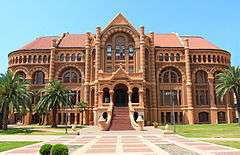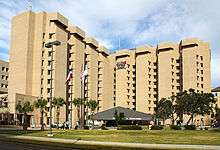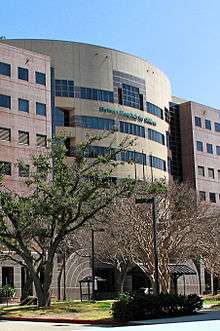University of Texas Medical Branch
 | |
| Motto | Disciplina praesidium civitatis (Latin) |
|---|---|
Motto in English | Cultivated mind is the guardian genius of democracy.[1] |
| Type | Academic Health Science Center |
| Established | 1891 |
| Endowment | $ 495 million[2] |
| President | David L. Callender, MD, MBA, FACS |
Administrative staff | 12,000 |
| Students | 3,169 (2,826 full-time equivalent) (Fall 2015)[3] |
| Location | Galveston, Texas, USA |
| Campus | Urban, 350 acres (140 ha) |
| Colors |
Red, white, and gray[4] |
| Website | www.utmb.edu |
 | |
The University of Texas Medical Branch (UTMB) is a component of the University of Texas System located in Galveston, Texas, United States, about 50 miles (80 km) southeast of Downtown Houston. It is an academic health center with 11,000 employees[5] and a medical school that is the oldest in Texas.[6] In February 2015 it had an endowment of $513 million.[7]
Established in 1891 as the University of Texas Medical Department, UTMB has grown from one building, 23 students and 13 faculty members to more than 70 buildings, more than 2,500 students and more than 1,000 faculty.[8] It has four schools, three institutes for advanced study, a comprehensive medical library, three on-site hospitals (including an affiliated Shriners Hospital for Children), a network of clinics that provide primary and specialized medical care and numerous research facilities.
UTMB's primary missions are health sciences education, medical research (it is home to the Galveston National Laboratory) and health care services.[9] Its Emergency Room at John Sealy Hospital is certified as a Level I Trauma Center and serves as the lead trauma facility for a nine-county region in Southeast Texas; it is one of only three Level I Trauma centers serving all ages in Southeast Texas.[10]
In fiscal year 2012, UTMB received 20 percent of its $1.5 billion budget from the State of Texas to help support its teaching mission, hospital operation and Level 1 Trauma Center; UTMB generates the rest of its budget through its research endeavors, clinical services and philanthropy. It provides a significant amount of charity care (almost $96 million in 2012), and treats complex cases such as transplants and burns.[11]
In 2003 UTMB received funding to construct a $150 million Galveston National Biocontainment Laboratory on its campus, one of the few non-military facilities of this level. It houses several Biosafety Level 4 research laboratories, where studies on highly infectious materials can be carried out safely.[12] It has schools of medicine, nursing, allied health professions, and a graduate school of biomedical sciences, as well as an institute for medical humanities. UTMB also has a major contract with the Texas Department of Corrections to provide medical care to inmates at all TDC sites in the eastern portion of Texas. UTMB also has similar contracts with local governments needing inmate medical care.
History


The location of the Medical Department of the University of Texas was decided between Galveston and Houston in a popular vote in 1881, but its opening was delayed due to the construction of the main university campus in Austin, Texas. The need for medical training in Texas was great: in 1891, 80% of doctors in the state had under a year of formal training in medicine, and so the "Texas Medical College" was formed in Galveston with the idea that it would become the medical department once state funding began.
The original building, now called Old Red, was begun in 1890 under the supervision of the Galveston architect Nicholas J. Clayton. Clayton toured several medical colleges in the North and East before drawing up his plans for the building. The medical school campus also included the John Sealy Hospital, which provided charity care for any who claimed Galveston residence.
Upon opening, the Red Building had been starkly underfurnished, a problem which was not fully remedied until after the Hurricane of 1900, when the state rallied around the ravaged city. Dr. Thompson, professor of surgery, said that "the regents were so generous in repairing the damage to the building and restoring the equipment, that we were actually in better shape at the end of the year 1901 than we had been before." In addition, the damage to the roof of Old Red allowed for the addition of skylights, which had always been wanted for the dissection room.
In 1915 the medical branch built the first hospital dedicated to children in Texas. By 1924 UTMB had established the first department of pediatrics in the state of Texas — which was also one of the first departments of pediatrics in the United States.[13]
UTMB’s annual budget of approximately $1.4 billion includes grants, awards, and contracts from federal and private sources totaling more than $150 million, in addition to institutional allocations for research.
In 1996, UTMB purchased the adjacent 128-year-old St. Mary's Hospital, the first catholic hospital in Texas.[14] The building was converted into the Rebecca Sealy Psychiatric Hospital.
UTMB became a member of the Houston-based Texas Medical Center in 2010.[15]
Dr. Danny O. Jacobs, a former Department Chair at Duke University, has been named executive vice president, provost and dean of the School of Medicine at the University of Texas Medical Branch, effective Oct. 1 2012.
Hurricane Ike
Hurricane Ike (2008) caused significant flood damage to nearly every building on campus, including the John Sealy Hospital. However, UTMB has about $1.4 billion to restore, harden and expand its campus. Much of the money was approved by the 81st Texas Legislative session, $450 million comes from FEMA, $130 million from insurance, $200 million from the Sealy and Smith Foundation, and $50 million from the Social Service Block Grant Funds. Reconstruction is actively underway as well as hardening of the campus to protect buildings and resources from future storms. It should be noted that UTMB restored its educational programs within weeks after the Hurricane Ike and the research endeavor came back steadily thereafter. In 2011 the foundation committed $170 million towards the construction of a new Jennie Sealy Hospital on the UTMB campus, an amount that represents the largest single gift ever to a Texas health institution.[16]
Facilities
Schools
UTMB includes four schools:
- School of Medicine - The School of Medicine at UTMB has provided medical school or residency training to one in six Texas physicians. With 20 departments, three institutes and a unique partnership with the University of Texas in Austin and Seton Healthcare in Austin, UTMB’s School of Medicine is a leader in medical school education, translational research and clinical care. The University of Texas Medical Branch (UTMB) is a major academic health center in the fields of health sciences education, clinical care and biomedical research. Opened in 1891.
- Graduate School of Biomedical Sciences - The Graduate School of Biomedical Sciences (GSBS) is one of four degree-granting schools at UTMB and plays a major role in research and scholarship at the university. Biomedical graduate programs were started in 1952, and a separate graduate school was established in 1969, becoming the Graduate School of Biomedical Sciences in 1972. There are 323 faculty members in the graduate school. UTMB maintains an excellent faculty-to-student ratio, with 341 graduate students enrolled and approximately 50 enrolling each year. The graduate school has 11 degree-granting programs: Biochemistry and Molecular Biology, Cell Biology,[17] Cellular Physiology and Molecular Biophysics, Experimental Pathology,[18] Master of Medical Sciences, Medical Humanities, Microbiology and Immunology, Neurosciences,[19] Nursing, Pharmacology and Toxicology, and Preventive Medicine and Community Health. Most of the programs and their facilities are closely allied with their medical school departments and also interact in interdisciplinary and clinical pursuits. An M.D./Ph.D. Combined Degree Program is offered in conjunction with the UTMB School of Medicine. The Graduate School of Biomedical Sciences provides a basic science background for its students. The GSBS and the UT Telecampus have created a concurrent enrollment program by which graduate students at UTMB can pursue both a Ph.D. and an M.B.A. in preparation for careers in biotechnology and the pharmaceutical industry, among other career opportunities.
- School of Nursing
- School of Health Professions
Science complex

From its modest beginnings in the 1890s as the first state medical school in Texas, the University of Texas Medical Branch at Galveston (UTMB) has developed into a large, sophisticated health science complex with numerous schools and institutes, including:
- a Graduate School of Biomedical Sciences,
- School of Medicine,
- School of Nursing,
- School of Health Professions,
- Institute for Human Infections and Immunity,
- Institute for the Medical Humanities,
- an affiliated Shriners Burns Hospital,
- the Sealy Center for Molecular Medicine,
- the Sealy Center for Structural Biology,
- the Center for Biodefense and Emerging Infectious Diseases,
- the Center for Addiction Research,
- the Educational Cancer Center,
- the Center for Interdisciplinary Research in Women’s Health,
- the Institute for Translational Sciences,[20]
- the Galveston National Laboratory (GNL),
- the Sealy Center for Cancer Cell Biology,
- the Sealy Center for Environmental Health and Medicine,
- the World Health Organization Collaborating Center for Tropical Diseases,
- the Stark Diabetes Center,
- the Center for Biomedical Engineering,
- the Center for Environmental Toxicology,
- the Sealy Center on Aging,
- the George P. and Cynthia Woods Mitchell Center for Neurodegenerative Diseases, and
- the Sealy Center for Vaccine Development.
UTMB operates an extensive clinical care enterprise with a wide variety of specialty programs.
Hospitals and clinics

- John Sealy Hospital — a 12-story, 414-bed general care teaching hospital.[21]
- Jennie Sealy Hospital — hospital serving geriatric patients as well as the Sealy Center on Aging.
- University Hospital Clinics Building — a seven story specialty clinics building
- UTMB Pediatrics and Children's Hospital — a six story children's hospital with 50 inpatient beds, 12 PICU beds, 30 newborn and 42 high acuity beds.
- R. Waverly Smith Pavilion — houses the university's gynecological, obstetrical and newborn nursery services, including the university's neonatal intensive care unit.
- Rebecca Sealy Hospital — houses UTMB's day surgery services, the Regional Psychiatric Hospital for Mental Health–Mental Retardation patients, and inpatient hospitalization programs for the Department of Psychiatry and Behavioral Sciences.
- Shriners Burns Hospital for Children — A 30-bed children's hospital specializing care and treatment of acute burns, patients needing plastic reconstructive or restorative surgery as a result of "healed" burns, and scarring and deformity of the face. It has an Intensive Care Unit with 15 acute beds, a reconstruction and plastic surgery unit with 15 reconstruction beds, three operating rooms, a multi-bed recovery room, and numerous clinics. It is a Verified Burn Center by the American Burn Association.[22]
- UTMB Criminal Justice Hospital — operated in collaboration with the Texas Department of Criminal Justice, the prison hospital has 172 inpatient beds, a multi-service ambulatory care center, a minor operating room with a recovery room, a telemetry unit of 12 beds, a medical intensive care unit of six beds and a 56-bed overnight holding unit.
Heliports
UTMB has two heliports: the Ewing Hall Heliport (FAA LID: 9TS7) and the Emergency Room Heliport (FAA LID: 9TA7).
Notable alumni and faculty
- Robin Armstrong, M.D. - Internal medicine, physician in Galveston County, and former vice chairman of the Republican Party of Texas
- Ernst Bertner - first president of the Texas Medical Center
- Greg Bonnen, M.D. - Neurosurgeon and UTMB assistant professor; Republican member of the Texas House of Representatives.[23]
- Minnie Fisher Cunningham - Suffragist, first president of the League of Women Voters
- Maurice Ewing - Geophysicist
- Hector P. Garcia - Surgeon, civil rights advocate
- Bernard A. Harris, Jr. M.D. - Astronaut
- Henry T. Lynch - cancer researcher
- Julian Martinez-Tica, M.D. - Anesthesiology, physician in Galveston County, and former Peruvian prime minister
- C. J. Peters M.D. - Virology and immunology
- Patricia Robertson M.D. - Astronaut-candidate
- Sean Roden, M.D. - former NASA flight surgeon
- Rosalyn Scott, M.D. - the first African-American woman to become a thoracic surgeon
- Robert Shope, M.D. - Arbovirologist and emerging infectious diseases expert
- Luther Leonidas Terry - Surgeon General
- William E. Thornton M.D. - Astronaut
See also
- Soule University, the 19th-century parent institution
- University of Texas System
- Texas Medical Center
Footnotes
- ↑ "The University of Texas Seal - Traditions". UT History Central. Texasexes.org. 1905-10-31. Retrieved March 29, 2015.
- ↑ "Endowment Information". UTIMCO. Retrieved October 31, 2015.
- ↑ "Education Facts". UTMB Health. University of Texas Medical Branch. 2015-10-26. Retrieved 2016-05-04.
- ↑ "UTMB Health: Visual: Color Palettes: Primary Palettes". UTMB Health. Retrieved 26 July 2013.
- ↑ "UTMB Data". University of Texas Medical Branch. Retrieved 8 May 2013.
- ↑ "UTMB School of Medicine". Retrieved 8 May 2013.
- ↑ http://www.utimco.org/scripts/PrivateEndowInfo/complist.asp
- ↑ "About UTMB Health".
- ↑ "UTMB not 'shirking' its charity care responsibilities". Houston Chronicle. Retrieved 8 May 2013.
- ↑ "Verified Trauma Centers". American College of Surgeons. Retrieved 8 May 2013.
- ↑ "Understanding Charity Care in Today's Health Care Environment". UTMB Health. Retrieved 8 May 2013.
- ↑ "UTMB on biowar front line / Lab funded by federal grant will seek defenses for terror 10/01/2003". Archives | Chron.com. Houston Chronicle. 2003-01-10. Retrieved 2012-11-24.
- ↑ Dannenmaier, Molly (17 April 2012). "UTMB's Children's Hospital makes its debut". Galveston Daily News. Retrieved 26 July 2013.
- ↑ "St. Mary's Hospital will close/UT branch to buy 128-year-old unit". Houston Chronicle. Retrieved 2009-10-03.
- ↑ Allison Wollam (2 March 2010). "UTMB becomes TMC member institution". Houston Business Journal. Retrieved 26 July 2013.
- ↑ Dawson, Jennifer (25 August 2011). "UTMB Galveston to build $438M hospital". Houston Business Journal. Retrieved 26 July 2013.
- ↑ "Cell Biology Graduate Program". University of Texas Medical Branch. Retrieved 26 July 2013.
- ↑ "Department of Pathology Home Page". University of Texas Medical Branch. Retrieved 26 July 2013.
- ↑ "Neuroscience Graduate Program". University of Texas Medical Branch. Retrieved 26 July 2013.
- ↑ "ITS - Institute for Translational Sciences". Institute for Translational Sciences. Retrieved 2012-11-24.
- ↑ "Description of Institutions". University of Texas Medical Branch. Retrieved 26 July 2013.
- ↑ "Galveston, TX". Shriners Hospitals for Children. Retrieved 26 July 2013.
- ↑ "Greg Bonnen's Biography". votesmart.org. Retrieved February 25, 2014.
Bibliography
- University of Texas Medical Branch at Galveston (1967). The University of Texas Medical Branch at Galveston: A Seventy-five Year History by the Faculty and Staff. Austin, Texas: University of Texas Press. LCCN 67028060.
External links
| Wikimedia Commons has media related to University of Texas Medical Branch. |
Coordinates: 29°18′39″N 94°46′38″W / 29.3107°N 94.7771°W